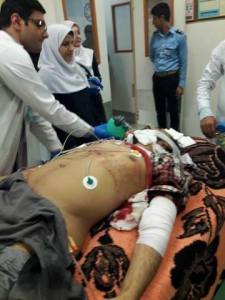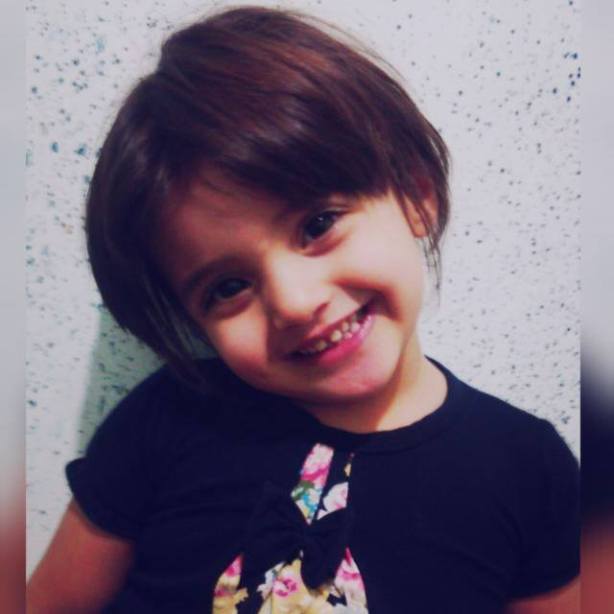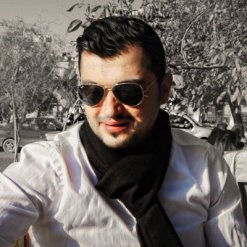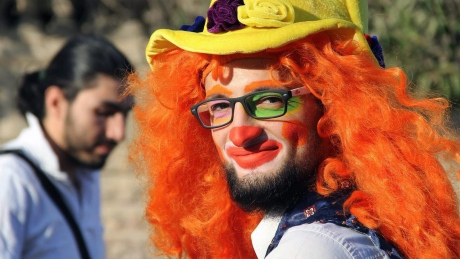
Saeed al-Bahrani died in the hospital of Mahshor (Mahshahr) city

Saeed al-Bahrani, 39 year old community activist
Written by Rahim Hamid, Ahwazi freelance journalist and human rights activist based in the USA
An Iranian regime militia shot an unarmed wheelchair-bound disabled Ahwazi activist dead in front of his wife and children in their home, apparently “revenge” for his civil rights activism.
The armed group belonging to the Basiji (also known as Sāzmān-e Basij-e Mostaz’afin), one of the five forces of the ‘Army of the Guardians of the Islamic Revolution’, stormed into 39-year-old Saeed al-Bahrani’s house in the town of Koura in southern Ahwaz capital on Sunday evening, April 2, 2017, shooting him dead in front of his horrified wife and three children. The regime militiamen gave no reason for their actions, with al-Bahrani’s wife and family having no legal recourse despite this brutal murder.
Saeed, aged 39, was a tireless community activist, a Sunni cleric and a widely admired and respected local figure in the poverty-stricken town, who spent much of his life engaged in campaigning for civil rights and freedom for the marginalised Ahwazi people.
Koura county is one of the most populated and deprived areas affiliated to Mahshahr port city, this port is the capital of petrochemical industry of Iran, however, its Arab locals denied any basic rights and employment in oil and gas petrochemical complexes have been driven to live in medieval poverty.
According to Ahwazi rights groups and activists, such cold-blooded murders of activists by the regime’s troops and militias are routine. Ahwazi activists say that the continuing silence of UN and other international human rights organizations on the Iranian regime’s rule by terror, in which grotesque human rights abuses are just another tool of governance, effectively gives the regime carte blanche to continue.
Ahwazi Arab activists on 26 February 2017 has circulated an amateur video on social networking sites showing an Ahwazi citizen lying on the ground, having been shot at by an Iranian police officer in the Zaafaraniya district, west of the capital of Ahwaz.
The police shot at the young Ahwazi man ‘in cold blood’, hitting him in the right leg, when he refused to be searched by them.
The video shows the young man unconscious and soaked in blood, with a crowd of concerned and angry people around him, while the police sit in their patrol car nearby.
Sources confirmed that the police did not call an ambulance to take the injured man to hospital until some of the locals from the Zaafaraniya district intervened and took him to a hospital in Ahwaz City Centre themselves. There were conflicting reports about the injured man’s latest condition, with some saying he has died of his injuries.
This is the fourth time within the last few months that there has been an incident of this kind. On 9 February of 2017, a random shooting by Iranian soldiers killed a young Ahwazi man in Falahiyeh City and another citizen was wounded in the city of Shush on Wednesday 22 February by Iranian intelligence.

Raghad Abbas, three-year-old victim.
Also, Ahwazi human rights activists have reported on October 27 2016 the murder of a three-year-old girl, Raghad Abbas (pictured), who died instantly on being shot through the heart as she sat in the back of her parents’ car when Iranian security forces opened fire indiscriminately on the vehicle on Monday October 24th. Her father, Abbas Hassan Mashal Al-Sari, aged 41, who was driving the car, and her mother, Zahor Abdul-Sada Al-Sari, were also critically wounded in the shooting, which took place in the Alawi neighbourhood, a western suburb of the regional capital, Ahwaz. Neither of her parents were armed or involved in any illegal activities, and no reason has yet been given for the attack, nor has any apology been issued for the murder of the little girl. Immediately after the brutal slaying, the security officers responsible dragged the injured, newly bereaved father, Abbas Hassan, from the vehicle and arrested him as his traumatized, also injured wife looked on, and as their daughter’s dead body sat in the back seat, before taking him to an undisclosed location.
The attack on the family’s vehicle was apparently part of another ongoing brutal crackdown by regime security forces on Ahwazi Arabs.
These random acts of violence are typical of the way the Iranian regime forces act in the Al-Ahwaz territories – taking pleasure in every opportunity to flaunt their complete control over every aspect of the civilians’ lives.
For years, the Ahwazi Arabs have been killed, shot, attacked, beaten, insulted and humiliated on a daily basis by the thugs of the Iranian regime, who act with impunity, secure in their knowledge that they have a carte blanche to act as they please.
As long as oil continues to flow from Ahwaz, many in the world seem quite prepared to turn a blind eye to the spilling of blood and shedding of tears of the dispossessed Ahwazi Arabs.
This is unacceptable. We pledge to continue to draw attention to the injustices being suffered by the Ahwazi Arab population until such time that justice and humanity will prevail.
For too long, Ahwazi Arabs have suffered in silence, the ultimate invisible victims. It is hard to understand just how isolated and betrayed the Ahwazi people feel, savagely persecuted by Iran for almost a century with the silent, treacherous complicity of the international community. Compounding this problem is the media blackout surrounding events in Ahwaz, with the current regime’s effective hermetic sealing off of the region assisted by the collusion of the world which is either wholly indifferent or swallows the Iranian regime’s obscene lie of ‘resistance to occupation’ wholesale.
Ahwazis face vast challenges in bringing attention to the plight of the people in a world constantly preoccupied with “more pressing concerns” and a region awash in systemic violence, much of it directly or indirectly courtesy of the same regime responsible for their suffering.
Need to mention that the core attention of the majority of Iranian rights groups has broadly been devoted to spotlighting the violations that are committed against persons that live in Tehran capital and central Persian regions. These organizations in their written goals claim that they are seeking democracy, civil freedom and putting an end to racial oppression and discriminations but such stated objects have never been put into action when they deal with the human rights issues linked to Ahwazi Arabs as well as other ethnic groups. Until about two years ago, there has not been even a simple statement or action by Iranian human rights organizations denouncing the execution and persecution perpetrated against the Arab people of Ahwaz. Only after many actions carried by Ahwazi activists only two or three organizations, among dozens of Iranian human rights organizations, took action by revealing the human rights violations in Ahwaz. The other organizations engaged in ultra-racist duplicity to evade highlighting the Ahwazi plight.
Despite living in the region which holds over 95 percent of the oil and gas resources claimed by Iran – the reason for the British backing of Iran’s 1925 annexation of Ahwaz in exchange for oil contracts – Ahwazi Arabs live in medieval poverty under an effective apartheid system, being viewed as inferiors due to their Arab ethnicity; most of the population exists below the poverty line, with limited or no access to jobs, education, healthcare, or even basic utilities such as electricity and gas or running water.
 Interview with Mahmoud al-Basha by Francesco Petronella, previously published in the print version of
Interview with Mahmoud al-Basha by Francesco Petronella, previously published in the print version of 









